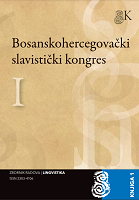Razvojna obilježja dječjega jezika u ovladavanju sintaksom hrvatskoga jezika
Developmental Features of Children’s Language in Acquisition of Croatian Language Syntax
Author(s): Katarina Aladrović SlovačekSubject(s): Phonetics / Phonology, Morphology, Syntax, Language acquisition, South Slavic Languages
Published by: Slavistički komitet BiH
Keywords: children’s language; early teaching of mother tongue; syntactic developmental features:
Summary/Abstract: Acquisition of language includes the occurrence of grammar, therefore it is strongly connected with the following language components: phonetics and phonology, morphology, semantics, lexicology, pragmatics and syntax. When the child produces its first word (1 – 1.5 year), this is the moment when its syntactic development begins. The sentences produced between the first and the second year are single-element expressions (so-called telegraph sentences of truncated structure (Jelaska 2007). About the age of two, the sentence is extended to become a two-element structure, while at the age of three the child already possesses a certain fund of words to which it can apply morphological rules and which it can arrange in more complex syntactic structures (Kuvač 2007). It is considered that the child extends its sentence by one word per year so that on the average, a seven-year-old child can produce a sentence of seven words (Pavličević-Franić 2005). The concept of the children’s language (Jakobson 1941, according to Bežen 2009) is a result of early language learning and it is a crucial issue of the language acquisition which does not end when the child enters school. Therefore, it is the aim of the research to determine the developmental features and their influence on acquisition of Croatian language syntax in early institutional teaching (from the age of 7 to the age of 12, i.e. from the 1st to the 6th grade of primary school). The corpus consists of written works of students (N = 174). The data will be analyzed by the method of content analysis and processed by the SPSS statistics software.
Journal: Bosanskohercegovački slavistički kongres
- Issue Year: I/2012
- Issue No: 1
- Page Range: 269-278
- Page Count: 10
- Language: Croatian

